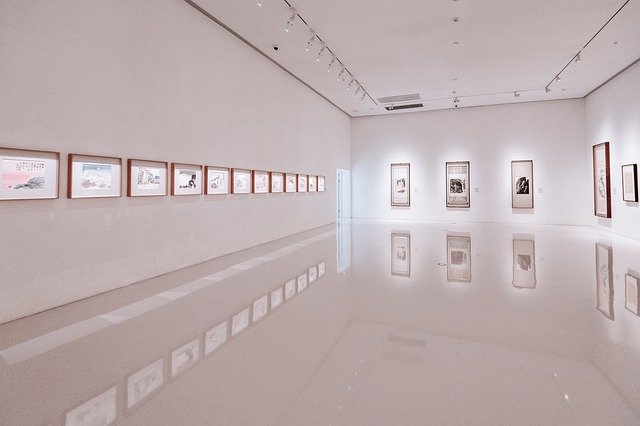Are you an art enthusiast or artist who wishes to have an art gallery of your own? If the answer is yes, you are probably wondering how to publicize your artwork and get your message across to your audience. This is a question that many newcomers have when starting out in the industry.
When it comes to finding the right plan to design your art gallery, there are no set rules. Common sense often comes in handy and the best way to get your gallery noticed is by hosting an event. An event is a useful medium as it allows you to inform the local press about what you do and meet some of your audience. Eventually, you will be able to make sales, foster positive relationships with the people who admire your work and collect new contacts for your mailing list.
The art gallery business is still in its development stage. This period can be considered successful for opening your own business in this area. If you are considering designing your own art gallery to display some amazing artwork, here are a few ideas to help you out:
- Location of the art gallery
Once you have decided to have your own art gallery, you first need to decide on the location for it. The best option is a building in the center of the city due to several reasons. Firstly, such areas are frequently visited by both residents and tourists to the city. This provides a large flow of random visitors who might not even know who you are and what you do. Secondly, a location in the center of the city indicates the high status of the gallery. It will instantly improve your brand image in the minds of your audience.
If you plan to buy the premises, it is advisable to give preference to new buildings; as such real estate can bring profit in case of resale. If you plan to acquire the space on rent, you should still go for a well-known location that will be easily accessible for your audience.
- Frames
To ensure effective running of the art gallery, 5 people are enough: gallery owner, curator, press secretary, consultant and exhibitor. The most important employee is the gallery owner, who, in fact, creates the gallery collection. His responsibilities include the selection of authors and work for exhibitions. The curator organizes exhibitions; the press secretary liaises with the media and the consultant works with potential buyers. The exhibitor works on exhibitions from an artistic point of view, developing the concept of each exhibition. If you are looking for a framing solution that is durable and creates high-quality displays, memorabilia framing is a great option to consider for your gallery. If the gallery has its own website, you can share it on social networks and it’s a good idea to get yourself a competent programmer.
- Size, layout, and ambiance
In general, any place with an area of about 200 square meters can be sufficient for an art gallery. Ideally, you should have about 50-80 square meters for the exhibition hall, 15-20 square meters for an office, and about 30 square meters for use as a storage space. Despite these figures, there are galleries whose entire area is less than 50 square meters! However, it is best to go for a space that isn’t too small. When you have sufficient space, it becomes possible to organize several expositions at the same time.
As for the interior of the gallery, it is best to avoid complex color schemes and textures. After all, you wouldn’t want the interior to divert the attention of the visitor from the objects of art presented in it. Therefore, neutral tones and a simple layout are best.
One of the most important elements of the interior of an art gallery is light. Pay attention to the lights – it can make a ton of difference. It is necessary to have good lighting in every corner of the room. That way, it will not be difficult for visitors to notice and admire the smallest details of each work.
The creation of the atmosphere in the gallery is another important element. Arrange some light music by investing in a high-quality stereo system. Moreover, the air temperature in the room should be just right. This means having a good heating system in the winter and air conditioning system in summer.
- Investment and income
Investments in objects of art and antiques are among the longest and at the same time most profitable types of investments. A person starting a business in this area has two options, the choice between which depends on the financial capabilities of the businessman.
You can get quick profits by investing in well-known artists who do not need advertising. The investment, in this case, can amount to thousands of dollars per artwork, but a successful re-sale can earn you a mark-up of 100%-300%. Another strategy can be to use artists who don’t have an established name in the market. This will significantly reduce the investment but at the cost of a longer payback period. In this case, there is also the risk that these new artists will not get their fame and you’ll lose your investment.
Experts advise to start by showcasing a collection of the work of at least five different artists, worth $800-$1000. You should spend a maximum of 20% of your total capital on them. At the same time, you should invest most of the money in the works of famous artists that can cost you about $2000-4000. In order to select authors for creating the initial collection, you can use the ratings drawn up by experts in the field. You can easily find artist ratings, art market indexes and practical investment tips.
However, the income of the gallery doesn’t only come from the sale of paintings. Today, many private art galleries set a price for the entry and inspection of their collections. This helps provide a decent amount of daily income, depending on the number of visitors. Another useful way to earn money is through themed events and lectures. It will also bring in a small amount of income and attract new visitors at the same time.
- Collaboration with others
There are a lot of active artists nowadays who wish to collaborate with others on different collections and exhibit them together to make for some great events for art enthusiasts. This is why, as an art gallery owner, it is important to foster positive relationships with painters, artists and photographers to organize some amazing events.
Conclusion:
The purpose of an art gallery is to sell art and earn a decent income in the process. The good news is that this is one industry where customers are prepared to pay very high prices for an artwork they like. Keep our tips in mind if you are looking to start an art gallery; they are sure to get you started on the right track. Good luck!





